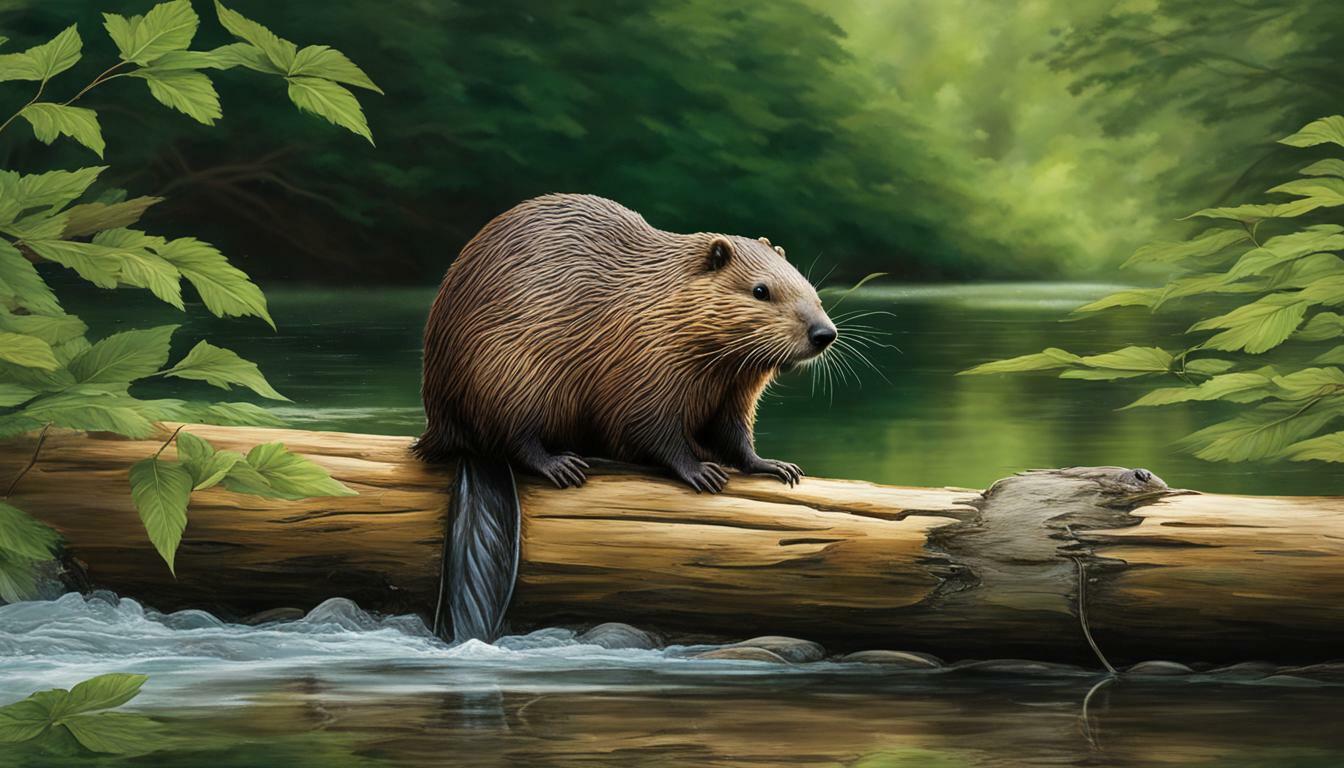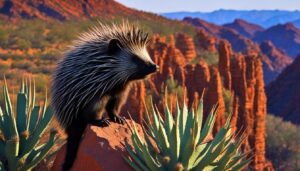If you’ve ever wondered if there are beavers in North Carolina, you’ll be pleased to know that these fascinating creatures do indeed inhabit the state. While their population was eradicated in the late 1800s due to trapping, efforts were made to reintroduce them in 1939. Since then, the beaver population has rebounded, and now there are estimated to be at least half a million beavers in North Carolina.
Beavers are known for their ability to build dams and lodges, creating ponds that serve as habitats for various plants and animals. While their activities can sometimes lead to property damage, there are methods available for managing their impact and coexisting with them. Trapping during regulated seasons is an option, and strategies like using water level control devices and protecting specific trees can help address conflicts.
All in all, beavers have become an important part of North Carolina’s natural landscape, contributing to the state’s ecosystem and providing opportunities for wildlife observation and conservation.
Key Takeaways:
- Beavers exist in North Carolina, with a population of at least half a million.
- They were reintroduced in 1939 after being eradicated due to trapping in the late 1800s.
- Beavers are known for their ability to build dams and lodges, creating habitats for various plants and animals.
- While their activities can sometimes cause property damage, there are methods available for managing their impact and coexisting with them.
- Trapping during regulated seasons and using water level control devices are some ways to address conflicts.
The History of Beavers in North Carolina
To understand the current beaver population in North Carolina, it’s essential to explore the history of these resilient rodents in the state. Beavers, once common throughout North Carolina, fell victim to widespread trapping for fur in the late 1800s, leading to their eradication. However, efforts to restore the beaver population began in 1939 when 29 beavers were brought from Pennsylvania.
Since their reintroduction, the beaver population in North Carolina has seen a notable increase. Today, it is estimated that there are at least half a million beavers residing in the state. These industrious creatures live in family groups and are known for their remarkable ability to build dams and lodges.
While the activities of beavers can sometimes cause conflicts with human infrastructure, their presence also brings several benefits. Beavers create ponds through their dam-building activities, which serve as vital habitats for various plants and animals. These wetland ecosystems support a diverse range of wildlife and contribute to the overall ecological balance in North Carolina.
The Role of Beavers in North Carolina’s Ecosystem
Beavers play a crucial role in shaping North Carolina’s landscape. By creating dams, they help control water flow, reduce erosion, and improve water quality. Their dams also promote the growth of wetland vegetation, which provides additional habitat and food sources for many species of birds, fish, and mammals. The presence of beavers in North Carolina is a testament to the resilience of these magnificent creatures and serves as a reminder of the importance of conservation efforts to protect their habitats.
| Year | Beaver Population in North Carolina |
|---|---|
| 1800s | Near eradication due to trapping |
| 1939 | Restoration effort begins with 29 beavers from Pennsylvania |
| Present | Estimated half a million beavers in North Carolina |
As the beaver population continues to thrive in North Carolina, it is important that we find ways to coexist with these remarkable animals while minimizing potential conflicts. Managing water levels, protecting specific trees, and employing other non-lethal methods can help mitigate damage caused by beaver activities. By balancing conservation efforts and responsible management, we can ensure the preservation of North Carolina’s beaver population and the invaluable contributions they make to the state’s ecosystem.
Beaver Restoration Efforts in North Carolina
In 1939, a significant milestone occurred in North Carolina’s wildlife conservation with the introduction of 29 beavers from Pennsylvania, marking the beginning of a successful restoration effort. These beavers were brought to North Carolina to revive the once-declining beaver population and restore their natural habitats. Since then, beavers have made a remarkable comeback and have become an integral part of North Carolina’s ecosystem.
Beavers, commonly known as North America’s largest rodent, are adapted to aquatic environments and possess unique traits that enable them to transform their surroundings. They are expert builders, constructing dams using branches, mud, and stones to create ponds that serve as their homes. These dams not only provide shelter for beavers but also create valuable wetland habitats for various plant and animal species.
While beavers’ activities can sometimes cause conflicts with human infrastructure, there are effective methods to manage and coexist with these industrious creatures. Water level control devices can be used to regulate the size of beaver ponds, reducing the risk of flooding. Additionally, protecting specific trees that provide essential food and building materials for beavers can help minimize damage to valuable vegetation.
| Benefits of Beaver Restoration Efforts |
|---|
| 1. Habitat Creation: Beaver ponds support diverse ecosystems, attracting a variety of aquatic plants, birds, and mammals. |
| 2. Water Regulation: Beaver dams help control the flow of water, preventing both droughts and floods. |
| 3. Soil Enrichment: Beavers’ activity enriches the soil by bringing nutrients from underwater to the surface. |
| 4. Climate Change Mitigation: The creation of beaver ponds can aid in carbon sequestration, contributing to climate change mitigation. |
Overall, the restoration efforts of beavers in North Carolina have been a resounding success. With an estimated population of at least half a million, these resilient creatures continue to shape the state’s landscape, benefitting both wildlife and the environment. Employing proper management techniques, such as water level control and tree protection, allows for peaceful coexistence and the preservation of North Carolina’s natural heritage.
Current Beaver Population in North Carolina
Thanks to the restoration efforts, the beaver population in North Carolina has made a remarkable recovery, with current estimates suggesting that there are at least half a million beavers residing in the state. Beavers, once nearly eradicated from North Carolina due to heavy trapping for their fur, were reintroduced in 1939 with the introduction of 29 beavers from Pennsylvania.
Since then, these industrious creatures have thrived in North Carolina, utilizing their remarkable building skills to construct dams and lodges that have transformed the landscape. Their activities, though sometimes causing property damage through flooding, also provide valuable habitat for a diverse range of plants and animals.
Beavers live in family groups known as colonies, and their dams create wetland environments that support a variety of species, including fish, amphibians, and waterfowl. These wetlands also help to filter and purify water, making a positive impact on the overall health of North Carolina’s ecosystems.
| Beaver Population in North Carolina | Estimates |
|---|---|
| Total Beavers | At least half a million |
Managing the beaver population is important to balance the needs of both humans and wildlife. Trapping during the regulated trapping season is one option, but there are also alternative methods available for living alongside beavers and managing their impact. Water level control devices can be used to prevent flooding, and protective measures can be taken to safeguard specific trees or property.
With their vital role in creating and maintaining wetland habitats, beavers have become an integral part of North Carolina’s natural landscape. As efforts continue to protect and coexist with these fascinating creatures, it is important to appreciate their impact on the environment and strive for a harmonious balance between human needs and the preservation of North Carolina’s natural heritage.
The Habitat and Behavior of North Carolina Beavers
North Carolina’s beavers have adapted well to their surroundings, showcasing fascinating habitat preferences and displaying unique behavioral characteristics. These industrious creatures are known for their ability to modify their environment to create ideal living conditions.
Beavers in North Carolina typically prefer freshwater habitats such as rivers, streams, ponds, and wetlands. They are most commonly found in areas with slow-moving or still water, as this allows them to construct their elaborate dams and lodges. These structures serve as their homes and provide protection from predators.
Table: Habitat Preferences of North Carolina Beavers
| Habitat | Features |
|---|---|
| Rivers and Streams | Slow-moving water, vegetation, and suitable bank materials for dam construction |
| Ponds and Wetlands | Still water, abundant food sources, and access to building materials |
Beavers are well-known for their dam-building abilities, which play a crucial role in shaping their habitats. These dams create ponds that benefit both the beavers and other wildlife. The ponds provide essential habitat for a variety of aquatic plants and animals, including fish, turtles, and amphibians. They also contribute to the overall health and biodiversity of the surrounding ecosystem.
It’s important to note that while beavers’ actions can lead to property damage through flooding, there are methods available to mitigate conflicts and manage their impact. Water level control devices can be installed to regulate pond levels and prevent excessive flooding. Additionally, protective measures can be taken to safeguard specific trees from beaver activity.
Table: Tips for Coexisting with Beavers in North Carolina
- Install water level control devices to manage pond levels
- Protect valuable trees through fencing or wrapping
- Monitor beaver activity and address any issues promptly
- Reach out to local wildlife authorities for guidance on managing beaver populations
Overall, beavers have become an important part of the natural landscape in North Carolina. Their role in creating diverse habitats and contributing to the overall health of ecosystems highlights the importance of understanding and coexisting with these remarkable creatures.
Beavers and Their Impact on North Carolina’s Wildlife
Beavers play a crucial role in North Carolina’s wildlife ecosystem by creating dams and altering their surroundings, which has both positive and negative effects on the local flora and fauna. These industrious creatures are known for their ability to build dams, which are essentially large barriers constructed across streams using branches, logs, and mud. The resulting ponds created by beaver dams provide crucial habitat for a diverse range of plants and animals. These water bodies attract and sustain various species, including fish, amphibians, reptiles, and waterfowl, which thrive in the wetland ecosystem.
The creation of beaver ponds also has a positive influence on the surrounding vegetation. The waterlogged conditions encourage the growth of aquatic plants, creating rich feeding grounds for many bird species. Additionally, these ponds serve as watering holes for numerous mammals, including deer, raccoons, and otters. The beaver dams can help mitigate flooding downstream by holding back excess water during periods of heavy rainfall. The slow release of this stored water also helps to recharge groundwater aquifers, ensuring a sustainable water supply for the surrounding ecosystem.
However, the presence of beavers and their dams can also have negative effects. The flooding caused by dams can result in property damage and impact human activities, such as agriculture and infrastructure development. Additionally, the changes to the landscape caused by beaver activity, such as felling trees to build dams and lodges, can alter the natural balance of the ecosystem and lead to changes in the composition of plant and animal communities. It is important to find a balance between conserving the beaver population and managing their impact on human interests.
The Impact of Beaver Dams on North Carolina’s Ecosystem
| Positive Effects | Negative Effects |
|---|---|
|
|
Understanding the ecological significance of beavers in North Carolina is essential for effective management strategies that consider both the needs of the wildlife and the local community. By implementing measures to minimize conflicts and promote coexistence, we can ensure the conservation of this fascinating species while preserving the balance of North Carolina’s diverse ecosystem.
Managing Beavers in North Carolina
As beavers continue to thrive in North Carolina, efforts are made to strike a balance between conservation and minimizing potential conflicts with human communities. The increasing beaver population in the state has led to a need for effective management strategies that promote coexistence and protect the interests of both beavers and residents.
Trapping remains one option for managing beavers in North Carolina. Regulated trapping seasons help control the population and reduce the risk of overpopulation. Trappers follow guidelines and regulations to ensure ethical and responsible trapping practices. This method can be effective in reducing beaver numbers in areas where their activities pose a significant threat to property or infrastructure.
However, there are also alternative approaches to managing the impact of beavers in North Carolina. Implementing water level control devices can help regulate beaver activity and mitigate the risk of flooding. By installing these devices, humans can control the water levels in beaver ponds and minimize potential property damage. Additionally, protecting specific trees from beaver damage can help preserve important vegetation while still allowing beavers to thrive in their natural environment.
Education plays a crucial role in managing beavers in North Carolina. Raising awareness about the ecological importance of beavers and their role in maintaining healthy ecosystems can foster understanding and appreciation for these creatures. By promoting coexistence and providing information about effective conservation methods, we can ensure that beavers continue to enrich the natural landscape of North Carolina while minimizing conflicts with human communities.
Table: Beaver Management Strategies
| Management Strategy | Description |
|---|---|
| Trapping | Regulated trapping seasons to control population numbers and reduce risks. |
| Water Level Control Devices | Installation of devices to regulate water levels in beaver ponds and mitigate flooding. |
| Tree Protection | Implementing measures to protect specific trees from beaver damage while allowing their habitat to thrive. |
| Education and Awareness | Raising awareness about beaver conservation, promoting coexistence, and providing information on effective management strategies. |
Coexisting with Beavers in North Carolina
Living alongside beavers in North Carolina can be a rewarding experience if we learn to respect their behavior and take appropriate measures to coexist peacefully. These industrious creatures play a vital role in our ecosystem, creating wetland habitats that support a diverse range of plant and animal species. However, it’s important to understand their behavior and implement strategies to minimize any potential conflicts.
One effective method for managing beaver activity is the use of water level control devices. These devices allow us to regulate water flow and prevent flooding, which can help protect our property while still allowing beavers to thrive. By installing a system that enables us to adjust water levels in beaver ponds, we can strike a balance that benefits both humans and beavers.
Another approach to coexistence is to safeguard specific trees that we value. Beavers are known for their ability to gnaw on trees as they construct dams and lodges. To protect trees of importance, we can wrap their trunks with wire mesh or install fences around them. By doing so, we can minimize damage to these cherished trees and still allow beavers to carry out their natural behaviors nearby.
| Coexisting with Beavers in North Carolina |
|---|
| Use water level control devices to regulate flooding and protect property. |
| Safeguard specific trees by wrapping trunks with wire mesh or installing fences. |
It’s worth noting that trapping during the regulated trapping season is also an option for managing beaver populations and mitigating conflicts. However, if possible, exploring non-lethal methods first is recommended, as it allows us to preserve the beavers’ important ecological role in North Carolina.
By understanding beaver behavior and implementing these coexistence measures, we can appreciate the remarkable contributions these animals make to our environment. From creating habitats for other species to enriching our landscapes with their engineering prowess, beavers have become an integral part of North Carolina’s natural heritage. Let us embrace the opportunity to peacefully coexist with these fascinating creatures, ensuring a harmonious balance between nature and human presence.
Conclusion
The resurgence of beavers in North Carolina showcases nature’s resilience and reminds us of the significance of preserving and protecting these remarkable creatures for future generations to enjoy.
Once eradicated from the state by the late 1800s due to fur trapping, beavers made a comeback in 1939 when 29 individuals were reintroduced from Pennsylvania. Since then, their population has thrived, and North Carolina is now home to an estimated half a million beavers.
Beavers are known for their unique ability to build dams and lodges, creating ponds that support a diverse range of plant and animal life. While their activities can sometimes result in property damage through flooding, there are methods available to mitigate conflicts and coexist with these industrious creatures.
If conflicts arise, trapping during the regulated trapping season is an option. However, there are also alternative approaches to manage the impact of beavers while protecting their habitats. Water level control devices can help regulate pond sizes, and strategically protecting specific trees can help balance their impact on the environment.
Ultimately, beavers have become an integral part of North Carolina’s natural landscape, providing invaluable ecosystem services and contributing to the overall biodiversity of the state. By understanding their behavior and implementing effective management strategies, we can coexist with these fascinating creatures while preserving their habitats and promoting their conservation for the benefit of future generations.
FAQ
Are beavers present in North Carolina?
Yes, beavers are present in North Carolina.
What happened to the beaver population in North Carolina?
The beaver population in North Carolina was eradicated by the late 1800s due to trapping.
Were beavers reintroduced to North Carolina?
Yes, in 1939, 29 beavers from Pennsylvania were reintroduced to North Carolina as part of a restoration effort.
How many beavers are there in North Carolina now?
It is estimated that there are now at least half a million beavers in North Carolina.
What are the habitat and behavior of North Carolina beavers?
Beavers in North Carolina live in family groups and are known for their ability to build dams and lodges.
What is the impact of beavers on North Carolina’s wildlife?
Beavers create habitat for a variety of plants and animals through their ponds, but their activities can also cause property damage through flooding.
How can beavers be managed in North Carolina?
Trapping during the regulated trapping season is an option, but there are also methods available for living alongside beavers and managing their impact, such as using water level control devices and protecting specific trees.
How can we coexist with beavers in North Carolina?
Coexisting with beavers in North Carolina involves understanding their behavior and implementing effective solutions to mitigate any negative impact.




